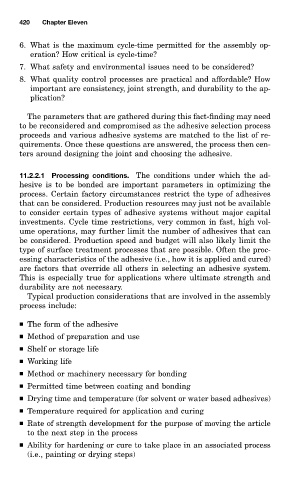Page 484 - Handbook of Adhesives and Sealants
P. 484
420 Chapter Eleven
6. What is the maximum cycle-time permitted for the assembly op-
eration? How critical is cycle-time?
7. What safety and environmental issues need to be considered?
8. What quality control processes are practical and affordable? How
important are consistency, joint strength, and durability to the ap-
plication?
The parameters that are gathered during this fact-finding may need
to be reconsidered and compromised as the adhesive selection process
proceeds and various adhesive systems are matched to the list of re-
quirements. Once these questions are answered, the process then cen-
ters around designing the joint and choosing the adhesive.
11.2.2.1 Processing conditions. The conditions under which the ad-
hesive is to be bonded are important parameters in optimizing the
process. Certain factory circumstances restrict the type of adhesives
that can be considered. Production resources may just not be available
to consider certain types of adhesive systems without major capital
investments. Cycle time restrictions, very common in fast, high vol-
ume operations, may further limit the number of adhesives that can
be considered. Production speed and budget will also likely limit the
type of surface treatment processes that are possible. Often the proc-
essing characteristics of the adhesive (i.e., how it is applied and cured)
are factors that override all others in selecting an adhesive system.
This is especially true for applications where ultimate strength and
durability are not necessary.
Typical production considerations that are involved in the assembly
process include:
The form of the adhesive
Method of preparation and use
Shelf or storage life
Working life
Method or machinery necessary for bonding
Permitted time between coating and bonding
Drying time and temperature (for solvent or water based adhesives)
Temperature required for application and curing
Rate of strength development for the purpose of moving the article
to the next step in the process
Ability for hardening or cure to take place in an associated process
(i.e., painting or drying steps)

